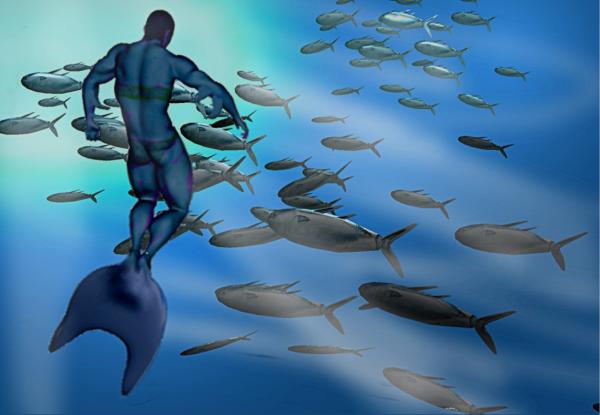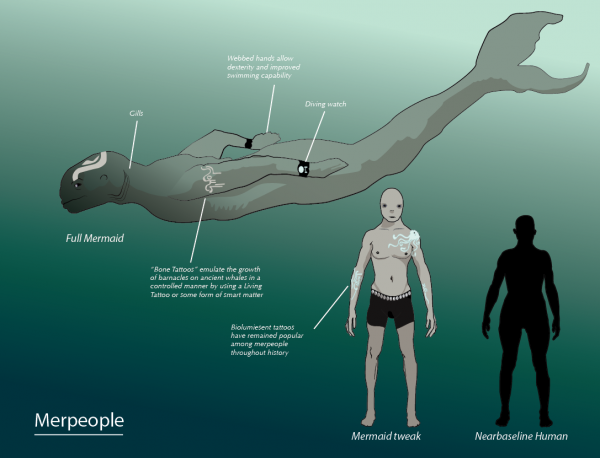BY LETTER
Merpeople
History > 0030 to 0900 AT: Solsys Era > 130 to 400 AT: The Interplanetary Age
Sophonts > Modosophonts > Tweak
Sophonts > Modosophonts > Tweak
When I'm being engenerated in an aquatic environment I like to request that my new body have a residual suffocation reflex. That first moment waking up in the pod begins with a jolt, a split second of alarm at the water filling my throat before new responses kick in and it feels natural. This small moment of panic and the relief that follows helps solidify the transition in forms for me. I like to do the same when transitioning back to a terrestrial form. There's nothing like the odd feeling that one's blowhole is blocked, followed by a satisfying, programmed sneeze.
Excerpt from Tyrol's Travel Notes: To the sea and back
The tweaks known as Homo aquaticus were the first true-breeding artificial species of human to become established during the Interplanetary Age. Several other species of aquatic human have been developed since that time, some more radically altered than others.
Development of the Merpeople
By 130 AT (the start of the 22nd century c.e.), attitudes to genetic engineering and advanced technology were changing rapidly. The public perception of the engineered had greatly improved, in no small part due to the growing population of superbright working together with the newly developed artificially intelligent computer systems (known as superturings) to repair widespread ecological degradation. This had been caused by the ill considered use of technology, fossil fuels and industrialised food production, and also by sporadic but environmentally damaging warfare during the previous hundred and fifty years. Particularly badly hit were the enclosed waters of the Mediterranean sea, which after decades of pollution and eutrophication were in large part barren and devoid of life.The project to restore the living ecosystem of the Mediterranean, MedRec S.A., was launched in 134a.t. Headed by a young superbright Nikolaus Vassiliou, with the assistance of the superturing AI NiarchosII and a large workforce consisting of everyone from former fisherman to biologists. The devastated waters were soon filled with remote drone submarines and underwater survey teams, including biochipped dolphins (there were as yet no geneered neodolphins) and seals. The rewarding challenges of working in the murky depths led the team to explore new possibilities for continuing their work long into the future. Vassiliou was a keen follower of genetic research into the evolution of marine mammals and was informed by contacts within the bioengineering corporation IntronTEK (soon after renamed GeneTEK) that mapping and extrapolation of various gene complexes had produced a number of possibly viable genotypes for marine humans. These extrapolations were based on cetacean and pinniped analogues and sounded ideal for the almost religious fervor the workers had for underwater ecological management. in 141a.t. Vassiliou pitched a grand project to IntronTek and was rewarded with a modest investment that led to the establishment of a small R&D seastead off the coast of Australia.
Over the next few decades years MedRec Aus. grew as it diligently brought to market minor commercial augmentations for traits such as clearer vision and higher blood oxygen content. These innocuous developments generated revenue that allowed the researchers to pursue a much greater task of a suite of genemods that would give rise to a properly aquatic human. Between 2130 and 2135 c.e. (161 to 166 a.t.) increasing numbers of MedRec volunteers "retired" to Australia in order to take part in semi-legal human experimentation to refine the mods. Viable individuals were not unveiled to the public until 175 a.t., although rumours had been circulating on the net for years. Because of the radical design of this first new human species, now formally named Homo Aquaticus, there was a great deal of shock and indignation amongst the religious community, and the Campaign for Human Purity was formed to lobby for the arrest of Vassilou and the prevention of further abominations. A clever use of memetics and spin by the superbrights and AI involved, and the winsome appeal of the young merpeople, managed to win over a large part of the population of the EU, who were by this time broadly tolerant of gene therapy and familiar with genetically enhanced chimpanzees and other pets. Some historians argue that what ultimately stayed the hand of heavy regulation (and serious fines against IntronTek's questionable profiteering) was the cost savings of a growing population physically and ideologically dedicated to the restoration of a vital aquatic ecosystem.
The Merpeople in the Solar System.
In the following centuries the Merpeople maintained an uneasy alliance with the surface dwellers. They were feted by the big entertainment corporations like Inscape and Universes Unlimited, idealised by many green, ecologist, and hippie feral groups, despised and feared by the Ludds and certain fundamentalist Christian factions (in 281 a.t. the Reverend Josh Harrel, head of the militant anti-tweak and anti-AI church Christian Redemption, called them "the wicked result of godless man's attempt at playing God"), and manipulated for political propaganda purposes by various governments and corporations. At any rate, it is doubtful that their population ever exceeded half a million. Image from Steve Bowers | |
| The merpeople of the Interplanetary Age did not have fins, so had to wear artificial flippers, like this monofin. | |
These early clades were not without their problems and crises. Living predominantly aquatic lives opened their bodies up to a host of infectious and parasitic diseases that their otherwise unaltered immune and wound healing systems were ill equipped to deal with. Merfolk life expectancy and general health was considerably lower than that of baseline humans. Major charity, government and commercial projects were bought to bear to correct this issue, though it would take many decades and billions of dollars before pharmaceutics and further gengineering could bring the population's health on parity with the rest. Some viewed such expenditure on such a small group to be a waste of resources, but others argued that beyond the humanitarian reasons humanity needed to develop experience in rapid medical development for new clades, lest every new species be born into a world with many risks and few treatments.
A further catalyse for investment in merpeople medical science occured in 390at when a Baseline Supremist hate group known as the Homo Sapiens Front released a gengineered virus especially designed to target merpeople. Hundreds died before an genetic antidote could be by GeneTEK and what was left of UNESCO. It is not known what happened to the original H.S.F. but they apparently disappeared rather mysteriously about the same time.
In the sixth century, Jovian Genetics & Adaptation further developed the merfolk genome (mostly somatically on volunteer adult populations) leading to a subspecies capable of surviving deep under the ice on Europa. Living in an anchor city hanging from the oceanic ice ceiling this clade quitely prospered until the technocalypse where they were thought lost. However, during the First Federation era, a small group was rediscovered living in the ruins and was reintroduced to wider society.
During the Nanotech Window of the early 6th century, when many of the impoverished baselines were trying make a break for the stars, it is known that several mergroups, seeking to escape from the interference and harassment of the surface dwellers, also launched ships - the SeaHorse, the Poseidon, and several others. It is not known what became of most of them; nine out of ten of the ships launched at this time never made it to their destination, some became Haloist, and of the remainder half are still in transit, travelling at sub-relativistic velocities to various corners of the universe.
The plagues. swarms and all the associated destruction that hit Earth several decades later spared neither merpeople nor surface dwellers, it is not (and probably never will be) known how many perished before the transapient known as GAIA emerged and erected a shield of defences that saved the Terran biosphere.
During the Great Expulsion of the 7th century, GAIA allowed the surviving merpeople to remain on Earth, along with a small population of land-dwelling nearbaselines, rianths, and splices.
Because of present restrictions on travel to Earth it is not known how many Merpeople remain on the planet, if indeed any still do. The Earth Rianths, the Ecologists, and the Priestesshood of Gaia rigidly control all outgoing information, and access is limited because of the defense systems GAIA has erected, and the rather trigger-happy valkyries She employs to take out curious freelance journalists and adventurers who try to land on Earth without permission.
Later History of the Merpeople
During the First Federation, the original merpeople species was confined to the resticted Earth. However a small group of merpeople was allowed by GAIA to visit the nearby system of Tau Ceti, at the invitation of King Stanley III, in 2491. The oceanographic institute of the Kingdom of Eyre decided to secretly replicate the genome of their visitors, assisted by genetic samples taken from the water in the accommodation they were allocated. From this small beginning a new species Homo Novaquaticus was developed. This radical new species was intended to live permanently within the water and was the first known clade to finally shed the humanoid form of the previous iterations. Due to this project a new diaspora of merpeople occurred as the Novan merpeople were free to emigrate and join the exploration of the galaxy.A major settlement of merpeople can be found at Zennor system in Libra, where several clades of merpeople have developed on the worlds of Lamorna, Sennen and Gweek, including the huge whale-like Megaptera species and the Zennorian mermen, famous for their impressive appearance and a common sight at ceremonial aquatic displays throughout the Terragen sphere.
 Image from Steve Bowers |
Related Articles
Appears in Topics
Development Notes
Text by M. Alan Kazlev and Steve Bowers.
Updated by Ryan_b 2016
Initially published on 23 July 2000.
Updated by Ryan_b 2016
Initially published on 23 July 2000.







